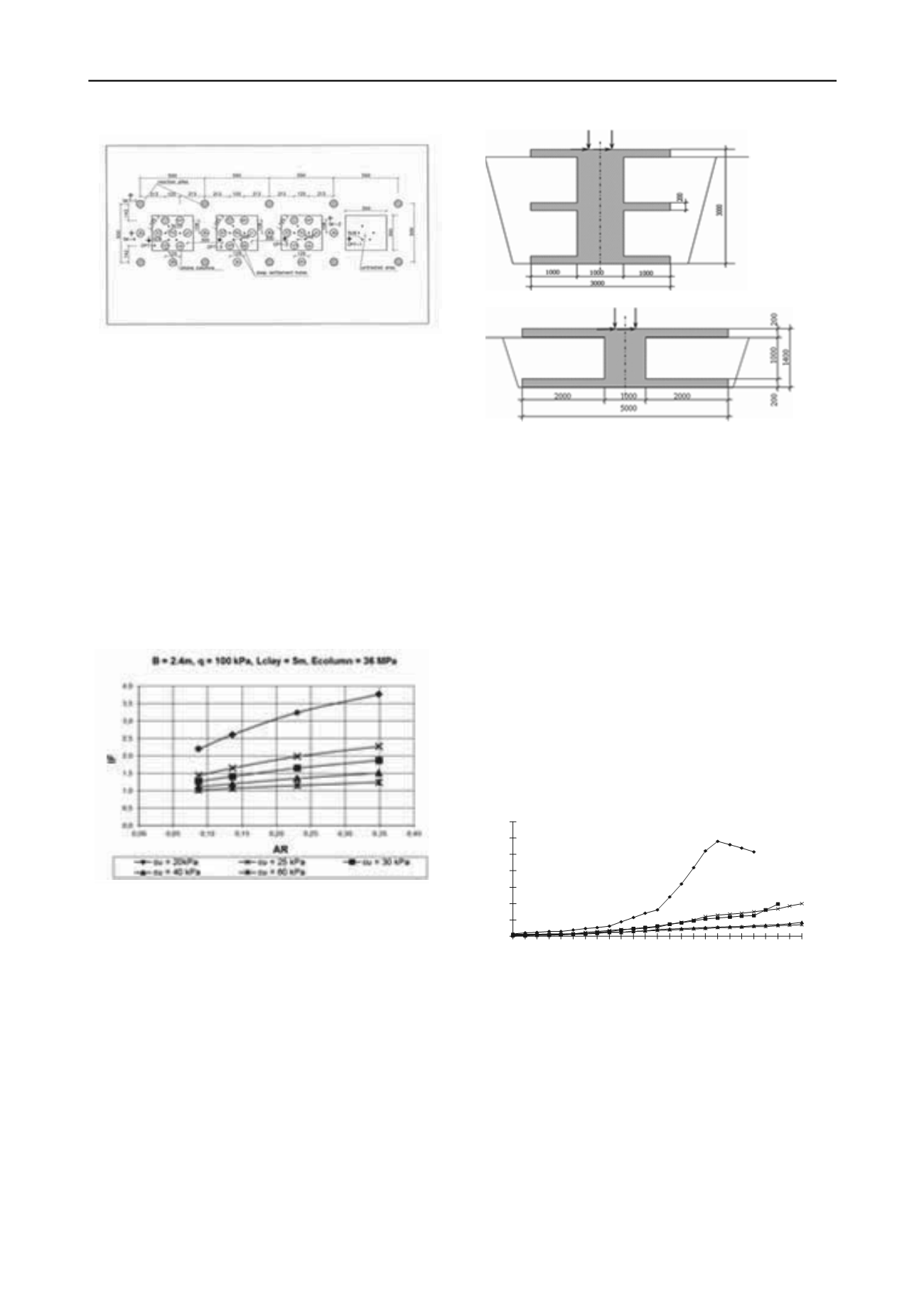
3437
Technical Committee CFMS /
Comité technique CFMS
Figure 12. Location of aggregate piers at the test site.
A simplified 3D finite element composite soil model was
then developed, which takes into account the increase of
stiffness around the piers due to the ramming process. Design
charts for settlement improvement factors of square footings of
different sizes (B = 2.4m to 4.8m) resting on aggregate pier
groups of different area ratios (AR = 0.087 to 0.349), pier
moduli (Ecolumn = 36MPa to 72MPa), and with various
compressible clay layer strengths (c
u
= 20kPa to 60kPa) and
thicknesses (L = 5m to 15m) were prepared using this calibrated
3D finite element model (see example in figure 13).
It was found that, the settlement improvement factor
increases as the area ratio, the pier modulus and the footing
pressure increase.
On the other hand, they observe that the settlement
improvement factor decreases as the undrained shear strength
and thickness of compressible clay and footing size increase.
Figure 13. Settlement improvement factor (IF) vs. area ratio (AR) charts
for a rigid square footing (B=2.4m) with a foundation pressure of q=100
kPa resting on end bearing rammed aggregate piers (L=5m, E=36 MPa).
Heavy machinery with rotating, reciprocating or impacting
masses requires a foundation that can resist dynamic loadings
and the resulting vibrations.
Y.Kirichek & V.Bolshakov
present in their paper new forms of foundations under machines
with low dynamic loadings. They are named «Combined
massive and plate foundations” (see Figure 14).
This type of foundations consists of deepened rigid solid
mass, and attached to it in soil, thin horizontal plates.
Its natural frequencies can be sat in a wide frequency range
by changing dimension and location of the attached thin
horizontal plates in soil.
(a)
(b)
Figure 14. Combined massive and plate foundations: (a) – a solid block
and three plates, (b) – a solid block and two plates.
As a result natural frequency of such foundation can be
significantly higher in amount than of block-type foundation,
and vibration level of the combined massive and plate
foundations under low-frequency loading and impacting
machinery generally is considerably lower.
For studying the behavior of the combined massive and plate
foundations under low-frequency, large-scale field loading tests
were conducted by
Kirichek & Bolshakov
. The comparison of
the footing vibration tests with theory was done. For these tests,
the vertical and horizontal dynamic forces on footing were
generated by rotating mass vibrators. The large-scale models
were 1.5 m in wide and 3.71 m in length.
The comparison of the amplitude-frequency responses of the
combined massive plate foundations enable to evaluate
influence of the dimension of plates on responses of foundation.
It shows that the vibration amplitude decreases half as much
with increasing of the plate area
F
twice as many.
The plate thickness
h
has less effect on the responses of
foundation (see figure 15).
0
50
100
150
200
250
300
350
8 12 16 20 24 28 32 36 40 44 48 52 56
А,mkm
f,Hz
1
2 4
3
5
Figure 15. Amplitude-frequency responses of the combined massive and
plate foundations with the plate on the top of the foundations to
horizontal periodic load: 1 – amplitude-frequency response of the block,
2 – F=2.13, h=0.05, 3 – F=4.5, h=0.05, 4 – F=2.13m, h=0.1, 5 –
F=4.5m, h=0.1m
It was experimentally determined that the effect of top plates
was more effective under horizontal dynamic loading and the
effect of bottom plates was more effective under vertical
dynamic loading.
A thin plate on the soil can significantly reduce the vibration
level of the block foundation.
6 ACKNOWLEDGEMENTS
We would like to thank the members of the Technical
Commission of the CFMS “Comité Français de Mécanique des


